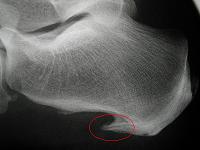Video: Heel Spur Treatment – No Surgery Necessary
What Are Heel Spurs and Do They Require Surgery?

Figure 1 – Heel Spur bottom of foot
Many of the patients we see at the Seattle Heel Pain Center ask if they have heel spurs and whether they need surgery to remove them. The first thing you should know is that you rarely need surgery to remove a heel spur.
A heel spur is simply an enlargement of the bone at the attachment point of the thick plantar fascia band that attaches into the heel bone. (see figure 1)
The main reason we know that surgery is rarely required for heel spurs is that chronic heel spurs do not hurt. What hurts is plantar fasciitis – inflammation and damage to the plantar fascia which may cause bone reaction and the formation of a heel spur. It is not the spur causing your pain, but the cause of the spur – the plantar fasciitis.
Why Do Heel Spurs Form?
Heel spurs form when the arch of the foot flattens excessively. When the arch flattens, the foot gets longer causing the plantar fascia to tighten. The tighter plantar fascia tugs on the heel bone and, over time, the bone reacts by forming a spur. Risk factors for heel spurs include:
- Abnormalities in your gait (how you walk) that cause your arch to flatten or put more pressure on your heel
- Running or jogging particularly on inflexible surfaces like pavement
- Shoes with inadequate arch support or shoes that don’t fit properly
- Excessive weight gain and/or obesity
Because heel spurs are caused by a tight plantar fascia, it is also important to understand the risk factors for this disorder. They include:
- Flat feet
- High arches
- Aging (all of our feet get flatter as we age and this increases tension on the plantar fascia)
- Jobs where you’re on your feet most of the time
Do Heel Spurs Cause Pain?

figure 2
Heel spurs are simply enlargements of bone that don’t poke into anything and so the spurs themselves do not usually cause pain. The underlying cause of the heel spur – a tight plantar fascia and subsequently plantar fasciitis – does cause pain. Pain from plantar fasciitis is caused by inflammation and damage to the ligament where it attaches to the heel bone. You can read more on plantar fasciitis here.
When the plantar fascia is inflamed at the bone insertion, you may see a hot spot on a bone scan (see figure 2) and/or bone marrow edema on an MRI scan. During the active bone formation phase, you may have an increase in pain. But once the spur finishes forming, your pain will recede. Thus, old heel spurs do not cause pain. Studies clearly show heel spurs are normal with aging but are more common in people who have experienced heel pain. You may actually have a larger spur on a foot without any symptoms. Only in rare causes do you need a heel spur removed.
What is the Best Treatment for Heel Spurs?
Since the underlying cause of the heel pain is usually plantar fasciitis and not the spur itself, treatment is usually focused on treating the plantar fasciitis. You can find detailed plantar fasciitis treatment information here, but in general, treatment goals include:
- Reducing tension on the plantar fascia
- Reducing inflammation
- Encouraging proper mechanics of the foot
Again, you can a full discussion of plantar fasciitis treatment here.
Video: How Orthotics Work to Reduce Heel Spur Pain
Heel Spur Surgery Is RARELY Needed
Heel spurs are simply a reaction caused by too much tugging of the plantar fascia on the heel bone. The bone reacts by forming a spur. The active inflammation caused by the pulling of plantar fascia on the bone is the cause of heel pain, not the spur itself. Because the spur is not the direct cause of pain, we are able to cure heel pain that’s caused by plantar fasciitis without surgery to remove your heel spurs.
Heel spur surgery was very common 20 years ago before the actual cause of plantar fasciitis pain was understood. Today, heel spur surgery is rarely performed. Expert and conservative treatment of plantar fasciitis that removes the tension usually takes the pain away – without surgery. The heel spur itself can remain on your foot forever and never cause you any pain.
Heel spur surgery has many potential complications and should only be considered as a very last resort. We highly recommend to anyone who has been told they need heel spur surgery to get a second (or even a third or fourth) opinion before proceeding.
If you are in the Seattle area, call us today to make an appointment at the Seattle Heel Pain Center. If you are experiencing heel pain, you can find some home treatment hints for heel pain here.




